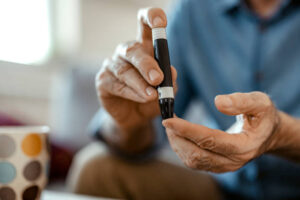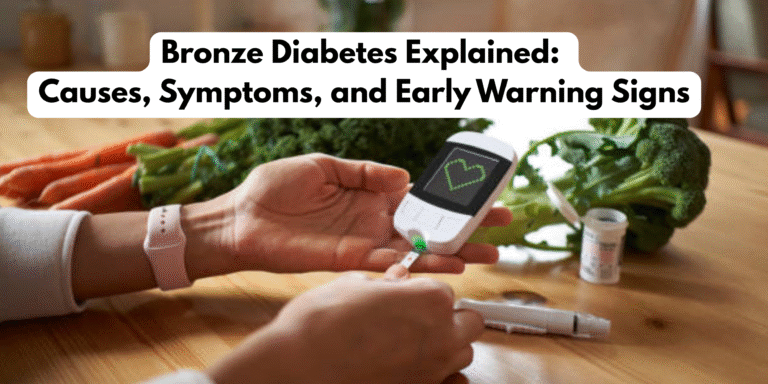Bronze Diabetes Explained: What Your Skin Tone Says About Your Blood Sugar
What Is Bronze Diabetes and How Does It Change Your Skin Before Your Blood Sugar Does?
What if your body was trying to tell you something not with symptoms like thirst or fatigue, but through your skin? Believe it or not, one of the earliest clues of diabetes might not come from a blood test at all, but from a subtle change in your skin tone.
That’s right, your skin can sometimes reveal what’s happening inside your body long before you notice any other symptoms. Doctors call it the “bronze warning sign,” a mysterious, golden-brown or darkened skin discoloration that can hint at hidden or undiagnosed diabetes.
In this post, we’ll explore how your skin color can serve as an early warning signal, what causes these changes, and how to identify the signs before diabetes progresses silently. This is your guide to understanding the bronze warning sign and what your skin might be trying to say about your health.

The Link Between Skin Color and Diabetes
Diabetes affects how your body processes sugar (glucose), but its impact goes way beyond blood sugar levels. When glucose builds up in the bloodstream, it can damage small blood vessels, nerves, and even alter skin cells.
For some people, this leads to a visible clue, a bronze or darker discoloration, particularly in areas such as the neck, armpits, elbows, knees, or even the face. Doctors often refer to this condition as acanthosis nigricans or diabetic dermopathy, depending on its appearance and symptoms.
These skin changes aren’t just cosmetic; they’re metabolic red flags. They can signal insulin resistance (a precursor to Type 2 diabetes) or, in some rare cases, an overload of iron known as hemochromatosis, which can also cause a bronzed appearance.
What Exactly Is the “Bronze Warning Sign”?
The “bronze warning sign” refers to a particular darkening or bronzing of the Skin that can occur when the body struggles to regulate insulin and glucose levels.
It might look like:
- A tan or bronze tint, even without sun exposure
- Velvety, darkened patches of Skin (especially around folds and creases)
- Dry, scaly, or shiny areas that seem to appear gradually
- Patches that feel thicker or smoother than the surrounding Skin
This change often begins subtly; you might think it’s just extra pigmentation or a lingering tan. However, if it persists or worsens over time, it may be a subtle indication that your body is responding to an insulin imbalance.
Acanthosis Nigricans: The Most Common Bronze Clue
Notice dark, velvety patches on your neck, underarms, or groin area. It may be acanthosis nigricans, one of the most common skin signs associated with diabetes and insulin resistance.
Here’s how it works:
When your body becomes resistant to insulin, it tries to compensate by producing even more of it. High insulin levels can cause skin cells to reproduce faster, especially those containing pigment (melanin). As a result, the affected areas darken and thicken, creating a soft, velvety texture.
Acanthosis nigricans doesn’t cause pain or itchiness in most cases, but it’s your body’s way of waving a flag that something’s off internally, particularly with insulin and glucose regulation.
Diabetic Dermopathy : The Bronze Patches on Legs
Another common skin warning sign of diabetes is diabetic dermopathy, sometimes called “shin spots.” These are light brown or bronze patches that typically appear on the shins, although they can also appear on other parts of the body.
These spots are caused by changes in small blood vessels — the same kind that can be affected by chronic high blood sugar. While they’re harmless and not painful, they serve as a visible marker of how diabetes impacts circulation and skin health.
Hemochromatosis When Too Much Iron Mimics Diabetes
In rare cases, the bronze skin tone may not be caused by diabetes itself, but rather by a condition called hemochromatosis, where the body stores excessive iron. Interestingly, hemochromatosis can also cause insulin resistance and lead to what’s known as “bronze diabetes.”
This condition gives the Skin a distinct bronze or grayish tone and can affect organs like the liver and pancreas. Left untreated, it can develop into full-blown diabetes, which is why the term “bronze diabetes” exists in medical history.
How to Tell If Your Skin Changes Could Be Diabetes-Related
It’s easy to dismiss skin discoloration as harmless or cosmetic, but here’s how to tell when it’s worth paying attention to:
- Location Matters
Darkening around the neck, underarms, groin, or joints is a classic sign of insulin-related skin changes.
- Texture Changes
If the Skin feels thicker, velvety, or slightly raised, it’s not just pigmentation — it’s likely acanthosis nigricans.
- Gradual Spread
These spots or patches often begin small and gradually increase in size. If the color or size changes over time, that’s worth noting.
- Accompanying Symptoms
If you’re also feeling unusually thirsty, tired, or hungry — or experiencing frequent urination — it may be more than a skin issue.
When in doubt, always get your blood sugar tested. Catching insulin resistance or diabetes early can make a huge difference in treatment and prevention.
The Science Behind Skin Changes and Insulin Resistance
To understand why your skin changes color, it is essential to examine the role of insulin beyond its primary function of regulating blood sugar levels.
Insulin isn’t just a sugar regulator — it also influences how cells grow and reproduce. When there’s too much insulin in your bloodstream, it can trigger an overproduction of skin cells, particularly in areas that fold or rub together.
At the same time, higher insulin levels stimulate the Skin’s pigment-producing cells (melanocytes), leading to darker tones. Combine these effects, and you get the bronze warning sign, a visible reflection of what’s happening deep within your metabolism.
Can Skin Changes Go Away After Diabetes Management?
The good news? Yes, in many cases, once blood sugar and insulin levels are brought under control, the bronze skin discoloration can lighten or fade.
Here’s what helps:
- Managing blood sugar levels through diet, medication, or lifestyle changes
- Losing weight if insulin resistance is a factor
- Improving skin care with gentle exfoliation and moisturizers
- Treating underlying causes, like hormonal imbalances or high insulin levels
However, skin changes often take time to improve, sometimes several months, because the body needs to restore balance from the inside out.
When to See a Doctor
If you notice new or unexplained dark patches, especially around your neck or underarms, it’s advisable to get them checked out.
Your healthcare provider may recommend:
- A blood sugar test (fasting glucose or HbA1c)
- Insulin level testing to check for resistance
- Iron studies to rule out hemochromatosis
- A skin examination to confirm the diagnosis
Early detection is key. The sooner you address the root cause, the easier it is to reverse or manage both the skin changes and the underlying condition.
Preventing the Bronze Warning Sign
While genetics and hormones play a role, lifestyle choices have a significant impact on preventing diabetes-related skin changes.
Here’s how to stay ahead of the curve:
- Balance Your Plate – Focus on high-fiber carbs, lean protein, and healthy fats. Avoid excess sugar and processed foods.
- Move Regularly – Even a 20-minute walk after meals can help your body use insulin more effectively.
- Stay Hydrated – Dehydrated Skin is more prone to irritation and discoloration.
- Maintain a Healthy Weight – Losing weight can significantly improve insulin sensitivity.
- Keep Skin Clean and Moisturized – Friction and dryness can worsen dark patches, so take gentle care of your Skin daily.
Real Talk When Beauty and Health Intersect
Your Skin isn’t just your body’s outer layer; it’s a messenger. Many people notice these subtle bronze or dark changes but ignore them, thinking they’re just cosmetic. Yet, in some cases, those spots are your body’s early warning signs of trouble.
Recognizing the bronze warning sign early could mean catching diabetes before it turns serious. It’s not about panic, it’s about awareness. The next time you see an unexpected color change in your Skin, think of it as your body’s gentle nudge to check what’s happening on the inside.
Your Skin Might Know Before You Do
Your Skin is like a mirror reflecting your internal health, and the bronze warning sign could be one of the earliest clues of hidden diabetes. Those subtle changes in tone or texture are your body’s way of saying, “Hey, something’s off, let’s fix this before it’s too late.”
By paying attention to your Skin and understanding the link between color changes and insulin resistance, you can catch problems early and take action.
So if you ever notice a bronzed, velvety, or darkened patch that wasn’t there before, don’t brush it off. It may be your body’s first hint that your blood sugar needs attention, a small sign that could lead to life-changing prevention.
If you want to dive deeper into the science behind bronze diabetes and how skin changes relate to blood sugar, check out the American Diabetes Association’s guide to skin health and diabetes. It’s a trusted source with doctor-backed info that helps you understand what’s really going on beneath the surface.





